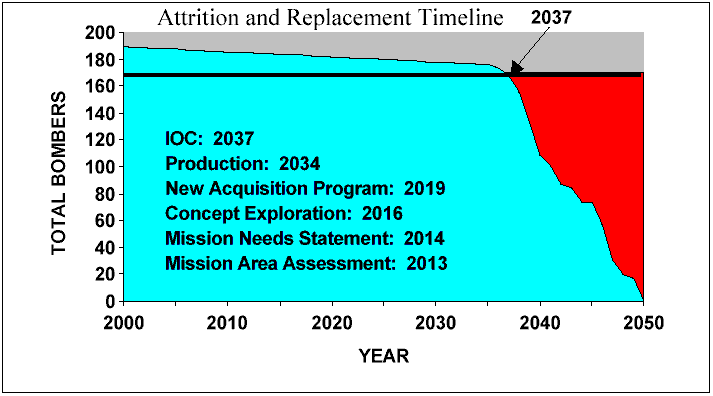




Under current plnas, the B-52, along with the younger B-1B Lancer and the new stealthy B-2 Spirit, will be kept around until approximately 2037, by which time the Air Force calculates that attrition will have reduced the fleet below the minimum 170 aircraft. The B-52s may fly to 2045.
Based on current operating procedures, attrition models, and service lives, the total bomber inventory is predicted to fall below the required 170 aircraft fleet by 2037. This date will become the target Initial Operational Capability (IOC) date for a follow-on to the current bomber capability, and an acquisition process can be planned by backing up from this date. Based on current projections for airframe economic service life and forecast mishap rate, initiating a replacement process no later than 2013 will ensure a capability to fill the long-range air power requirement as the current systems are retired. There are, however, additional concerns besides service life and mishap rates that could shift this replacement timeline. Changes in employment concepts, driven by technological advances in munitions and threats, or improvements in industry�s ability to perform cost effective major structural extensions could extend the today�s bomber force well beyond current projections. This may shift the acquisition timeline for a replacement capability further into the future.


The Light Bomber (Manned) concept calls for a medium-sized aircraft that blends the advantages of a tactical fighter with a strategic bomber to develop a medium/long range, high payload capability (inter-theater) affordable bomber. The aircraft will utilize some level of low-observable technology to obtain an effective yet affordable aircraft which can provide for multiple/heavy weapons carriage and launch for missions requiring real time decision making/replanning or autonomous operations. Cost would be controlled by utilizing off-the-shelf systems and affordable stealth technologies (JSF technology). Logistic support would be enhanced by maximizing commonality of support equipment with existing systems.
The Bomber Industrial Capabilities Study was directed by Congress, chartered by the DOD, and conducted by The Analytic Sciences Corporation (TASC). The study concluded that building a new bomber type, a B-3, could easily cost in excess of $35 billion for research and development alone (with unit flyaway costs about the same as a B-2).
Technology concepts from the USAF Scientific Advisory Board's (SAB) New World Vistas and technology concepts submitted for the 2025 Study were reviewed and concepts harvested from these efforts included the Future Attack Aircraft. This concept envisions a 500-nm-range manned or unmanned aircraft that would use stealth technology (both RF and IR) to reach a target and employ laser or high-power microwave (HPM) weapons. An unmanned aircraft with a "tunable" HPM weapon could provide either the nonlethal or lethal punch SAF needs in the constabulary mission.
Two concepts currently under consideration by Air Force Materiel Command include:
A 1999 RAND Corporation study articulated a rationale for acquiring a Mach 2 supersonic bomber with the following characteristics